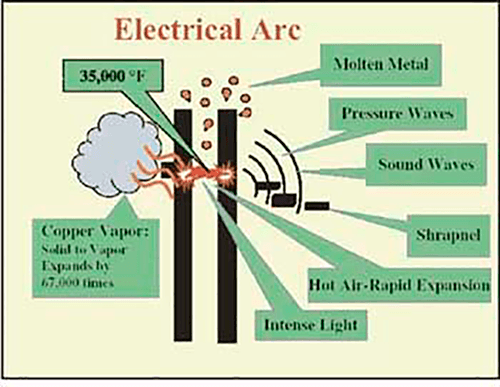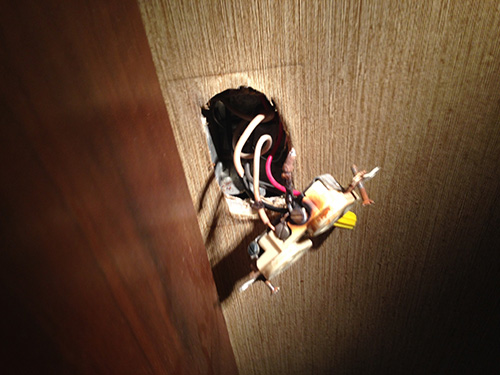What are arc-fault circuit interrupters (AFCIs)?
Arc-fault circuit interrupters (AFCIs) are a special type of electrical receptacle outlets (circuit breakers) that are designed to detect and respond to potentially dangerous electrical arcs in your homes branch wiring.
In 2005, according to statistics from the National Fire Protection Agency (NFPA), electrical fires damaged approximately 20,900 homes, killed approximately 500 people, and damaged over $860 million in property. Although short-circuits and overloads account for some of these fires, arcing is responsible for the majority of them which are undetectable by traditional (non-AFCI) circuit breakers.

How does AFCI work?
AFCIs work by continually monitoring the electrical waveform which promptly open and turn off (interrupt) the circuit they are installed on. They are designed to detect any significant changes in the wave-pattern that show the characteristic of a dangerous arc. They are definitely not your grandfather’s circuit breaker. AFCI’s are also capable of distinguishing a safe, normal arc; such as, those created when you turn on a switch or plugin your devices into a receptacle to arcs that may cause an electrical fire.
.

Where is arcing likely to form?
Arcing will form where wires are improperly installed or when the insulation on the wire becomes damaged. In older homes, the wire insulation will tend to crystallize as it ages, making it very brittle and prone to cracking, chipping and deterioration. Then, the damaged insulation exposes the current-carrying wire to its surroundings which increases the chances that an arc will occur.
Some situations where arcing may occur:
- Electrical cords that are used improperly or damaged by being pinched beneath furniture or doors.
- Wire insulation damaged from nails or screws driven through walls.
- Appliance cords damaged by over-heating, natural-aging, kinking, impact or improper installation.
- Rodents or animals chewing on the wires.
- Loose connections in outlets, switches and light fixtures.
- Improper installation by an unlicensed person

What is electrical arcing?
Electrical arcing happens when electric current overcomes or crosses an air gap from an energized component to a grounded component. Electrical arcing produces a glowing plasma discharge which is referred to as an arc. For example, a bolt of lightning is an extremely large and powerful arc that crosses the atmospheric air gap from an electrically charged cloud to the ground or another cloud. Just as lightning can cause fires, arcs that are produced by your home’s wiring are capable of producing high levels of heat that can ignite their surroundings which cause to electrical fires.

Where are AFCIs required?
Locations in which AFCIs are required depend on the county’s building codes adopted by the jurisdiction.
The 2014 NEC (National Electrical Code) NFPA 70 requires AFCIs be installed on the following circuits:
For new construction dwelling units:
All 120-volt, single phase, 15- and 20-ampere branch circuits which supply power for lighting and receptacle outlets that are installed in kitchens, family rooms, dining rooms, living rooms, parlors, libraries, dens, bedrooms, sun rooms, recreation rooms, closets, hallways, or laundry areas. These areas shall be protected by a listed combination-type arc-fault circuit interrupter, which is installed to provide protection of the branch circuit.
For existing dwelling units:
Branch circuit extensions or modifications in any of the areas previously listed in the new construction column, where branch circuit wiring is modified, replaced, or extended, the branch circuit shall be protected by a listed combination-type arc-fault circuit interrupter, installed to provide protection of the branch circuit.
Are AFCIs a nuisance?
An AFCI might activate in situations that are not dangerous and create needless power shortages. This can be particularly annoying when an AFCI stalls power to a freezer or refrigerator, allowing its contents to spoil. There are a few procedures an electrical contractor can perform in order to reduce potential “nuisance tripping”:
- Making sure to check that the load power wire, the panel neutral wire, and load neutral wire are properly connected and not improperly shared.
- Checking the junction boxes, fixtures and receptacle connections to ensure that the neutral conductor does not contact a grounded conductor.
Arc Faults vs. Ground Faults
It is important to distinguish Arc Fault Circuit Interrupter (AFCI) devices from Ground Fault Circuit Interrupter (GFCI) devices. GFCIs detect ground faults, which will occur when current leaks from a hot (ungrounded) conductor to a grounded object, resulting in a short circuit. This situation can be hazardous when a person unintentionally becomes the current’s path to the ground. GFCIs function by constantly monitoring the current flow between hot and neutral (grounding) conductors, and activate when they sense a difference of 5 milliamps or more. GFCIs are intended to prevent personal injury due to electric shock, while AFCIs prevent personal injury and property damage due to structure fires.
In conclusion, AFCIs are designed to detect arcs of electricity before they have a chance to lead to a structure fire and are always recommended for circuits in dwelling units. It’s like having an electrician in your panel to turn off the power if there is a serious problem.


